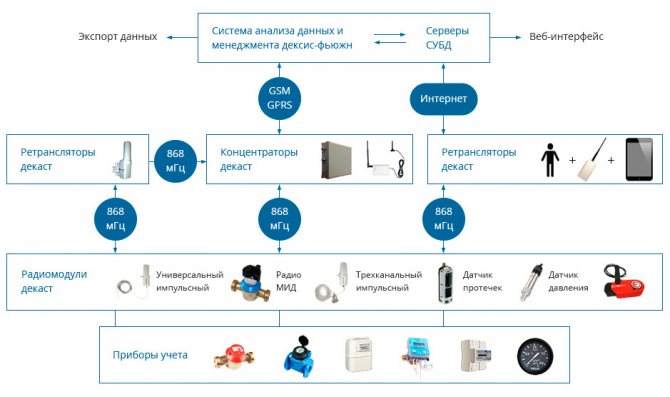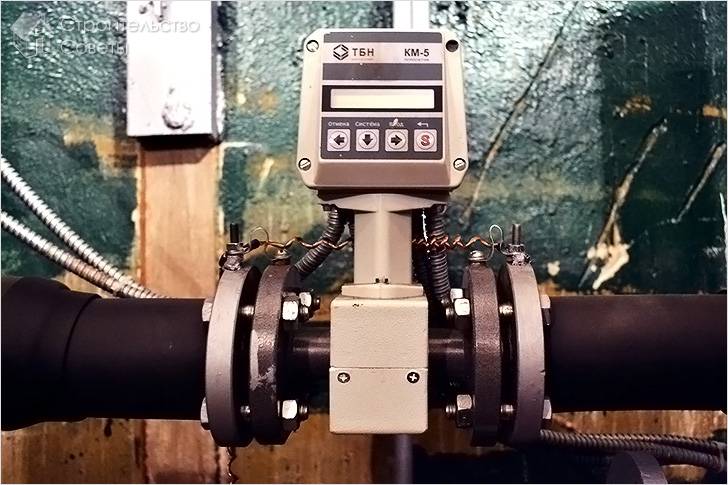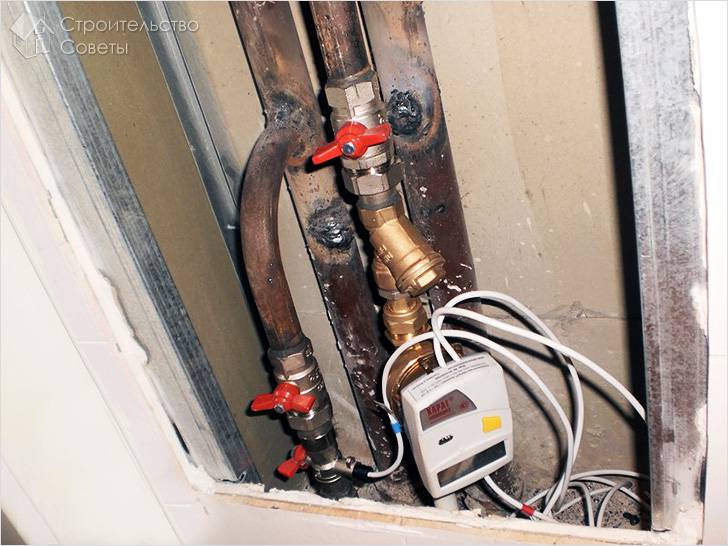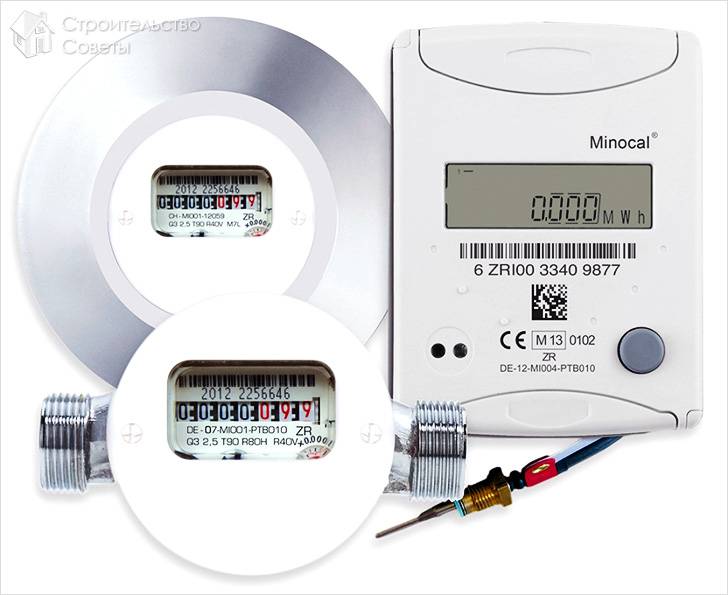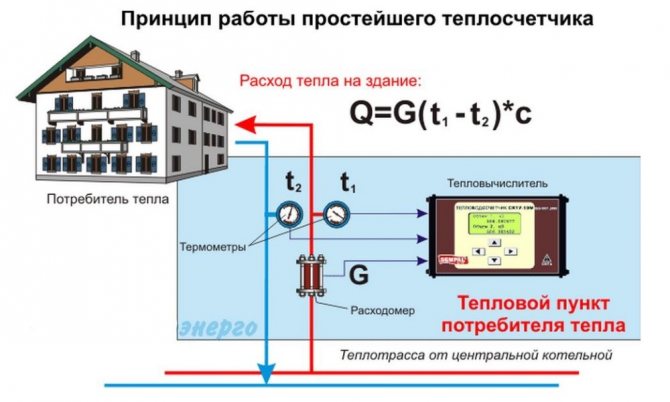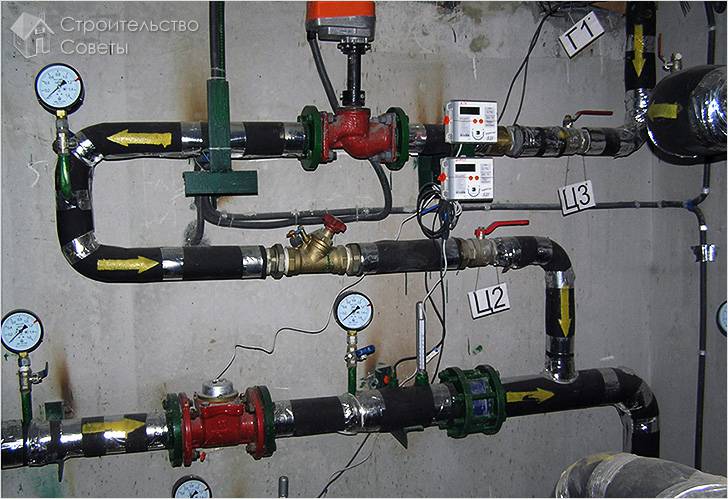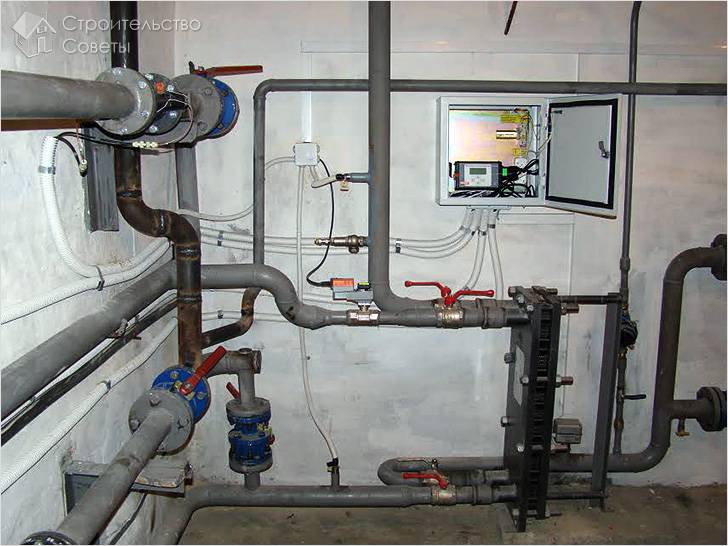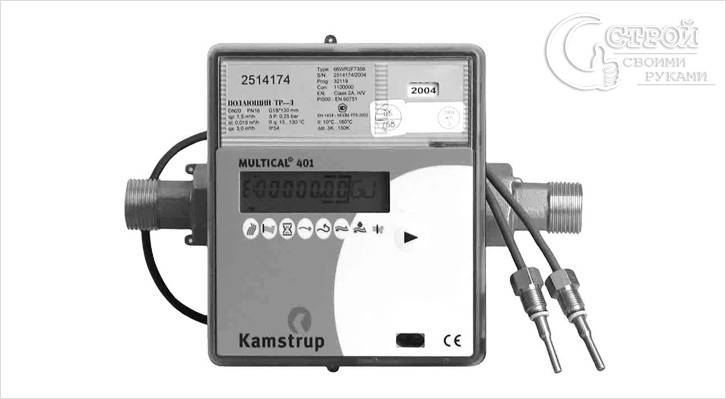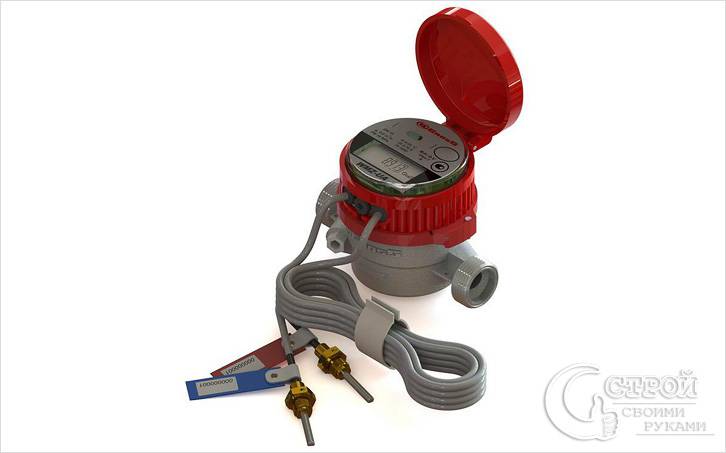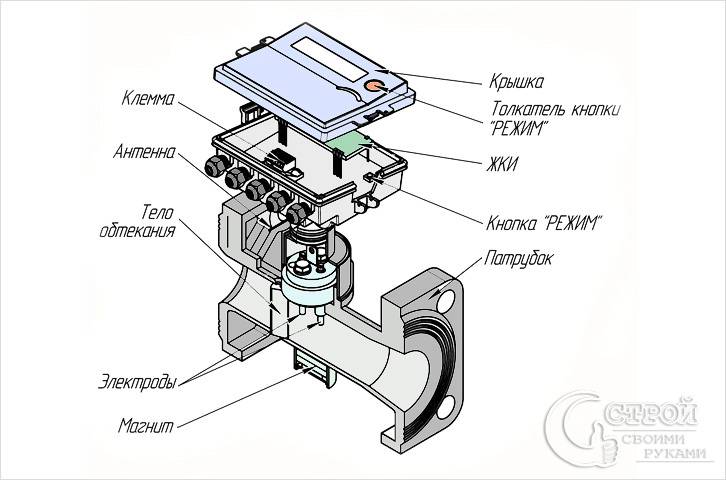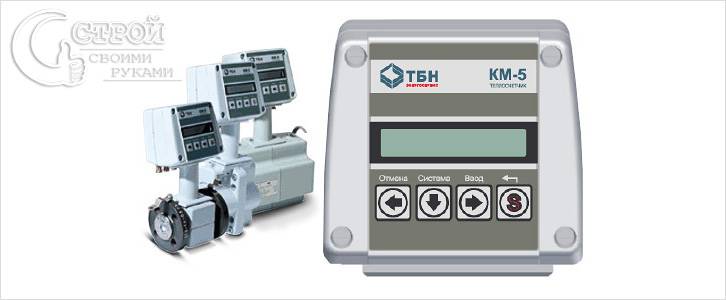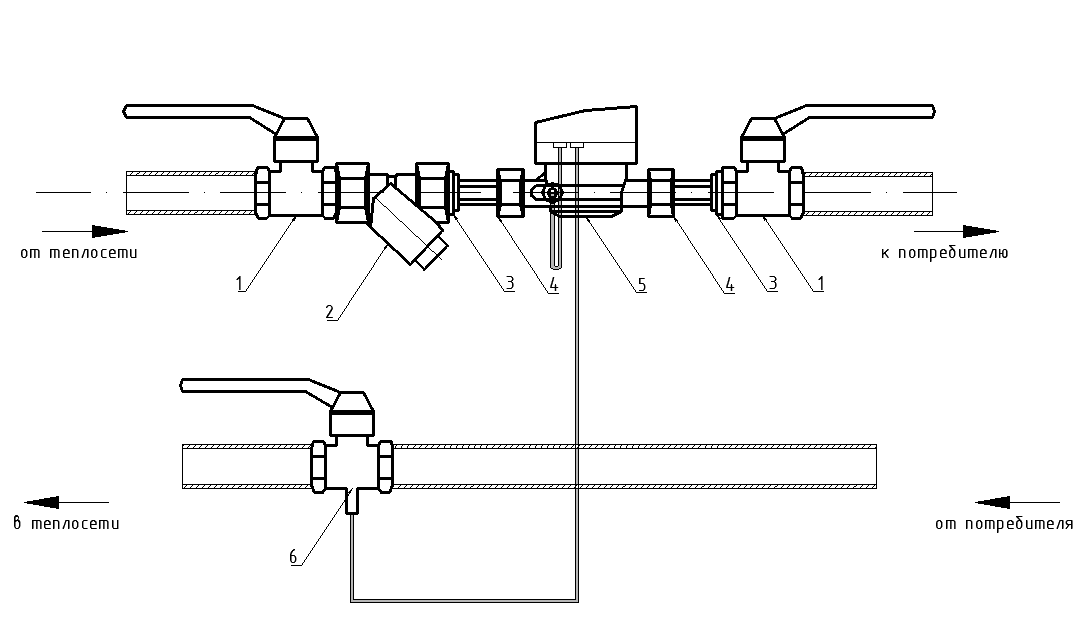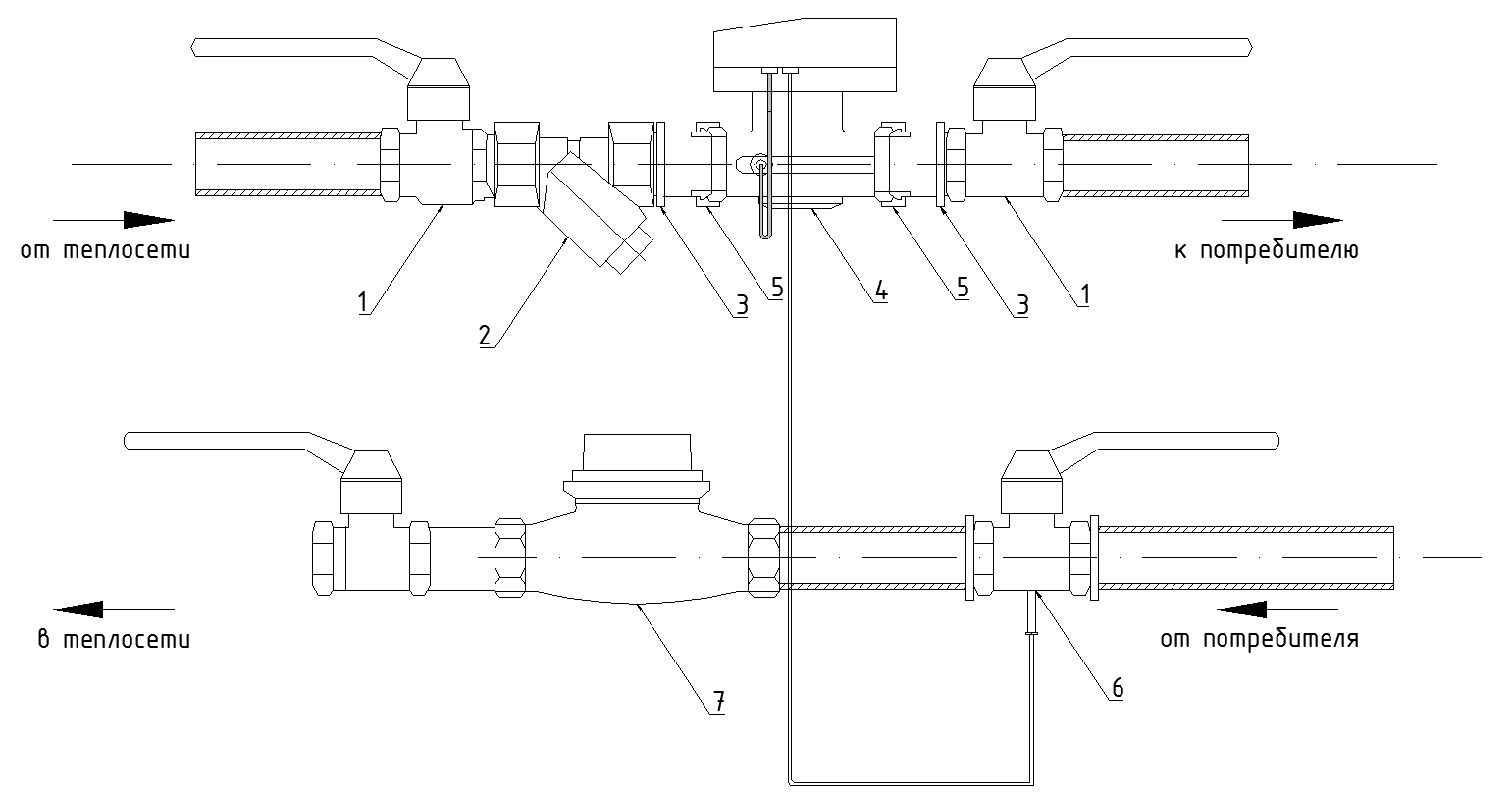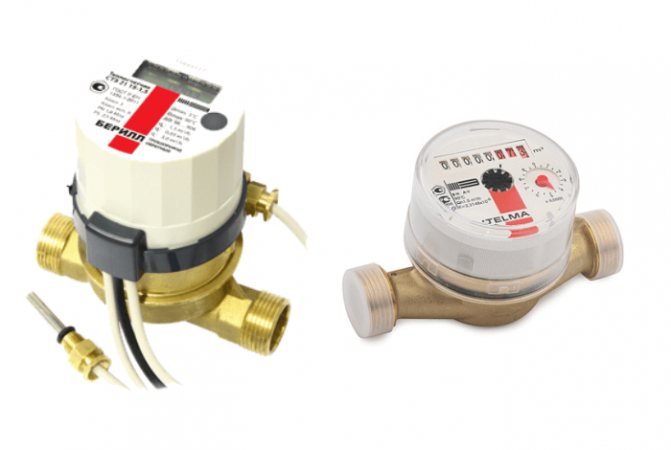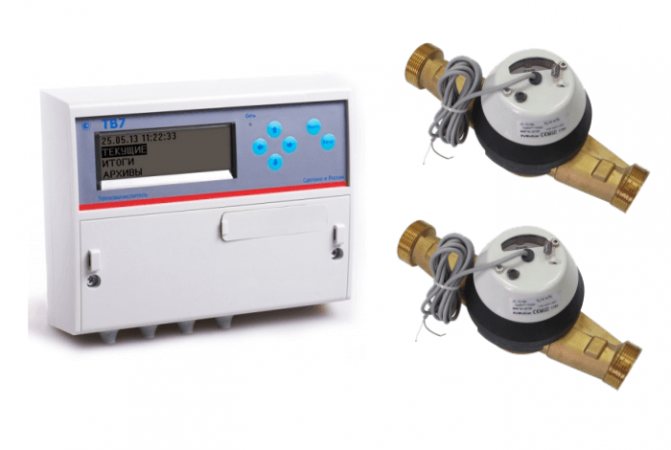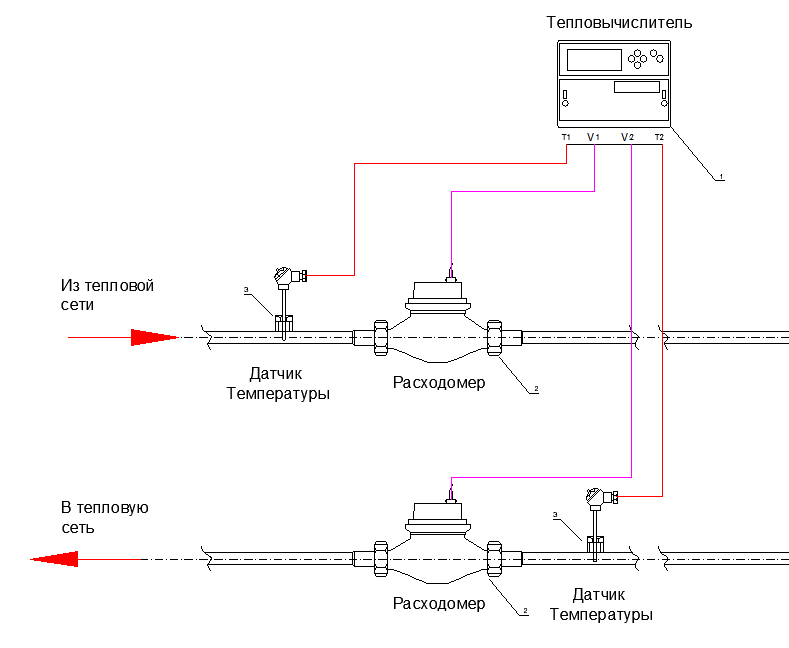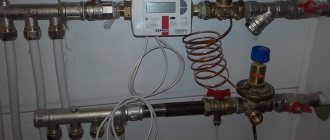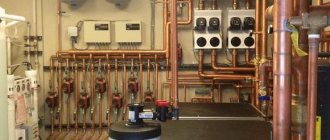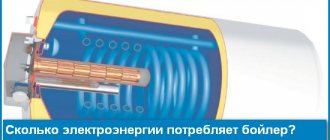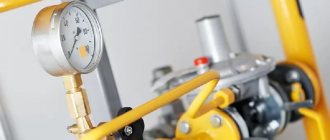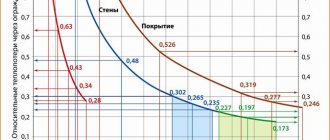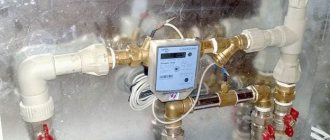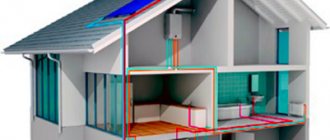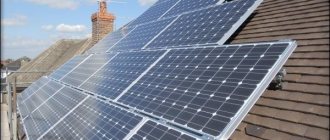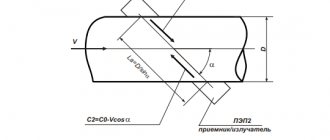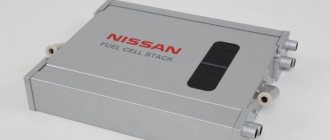Published by lpunity in 12.11.2018
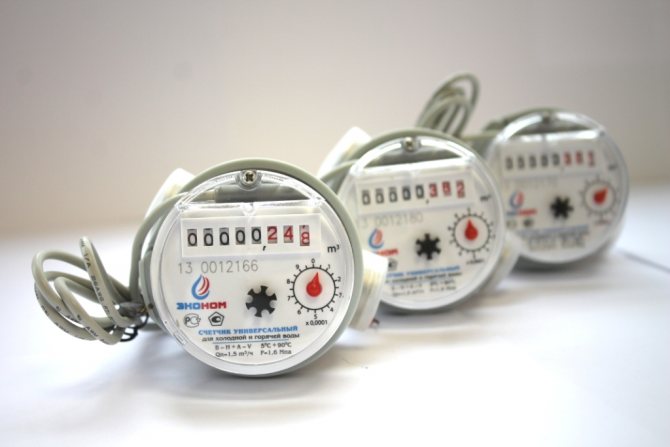
During the cold season, the highest utility bills come from heating. Sometimes the amounts in them seem unreasonable, extremely high. To know exactly how much heat you are paying for, you need to install a heat meter.
But the installation itself will not change the situation, and the size of the invoices will remain the same. To control the flow, you will need to regularly take readings of the heat meter. In this case, the homeowner will be sure that the amount on the receipt corresponds to the actual consumption, and that no excess volume has been charged.
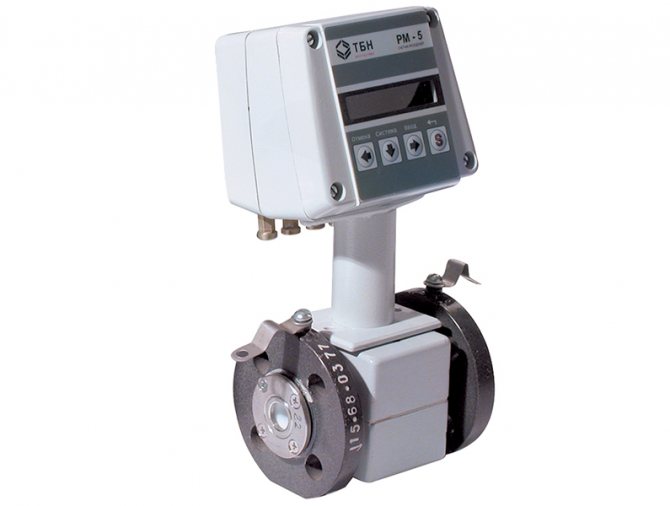

What you need to consider when deciding to install a meter
Some difficulties may arise depending on your heating system wiring diagram. So with a horizontal wiring scheme, it will be enough for you to put one meter at the entrance of heating pipes to the apartment, but what if you have a vertical scheme. I have a vertical scheme in my apartment and 4 risers of heating pipes, and it turns out that when installing a heat meter, I will have to install one meter for each heating device. Naturally, this option is not profitable, but not all that bad. Manufacturers of heat meters produce distributors that measure the flow rate of the coolant based on the difference between the surface temperature of the heating device and the temperature of the internal air. The cost of this equipment together with the installation will be approximately from 3 to 7 thousand rubles, it all depends on the equipment configuration.
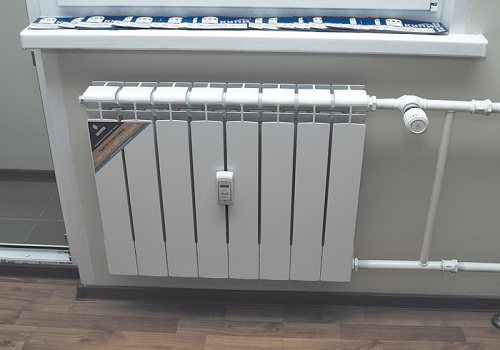

How to install a heat meter in an apartment?
Regarding the general house meter, we can say that its indisputable advantage is its low cost. However, the expected economic effect from its installation will not be so tangible. This is due to the fact that the entrance may turn out to be poorly insulated, and a lot of energy will be spent on heating it, the payment for which will fall on the shoulders of the residents.
In houses with vertical piping
In apartment buildings of an old building, as a rule, there is a vertical distribution of heating pipes. In this case, you will need to install a separate metering device on each of the risers in the apartment, which makes this procedure extremely costly.
In such a situation, the installation of special metering devices on the batteries would be a good solution, however, in our country (unlike in Europe) such heat meters are not used.
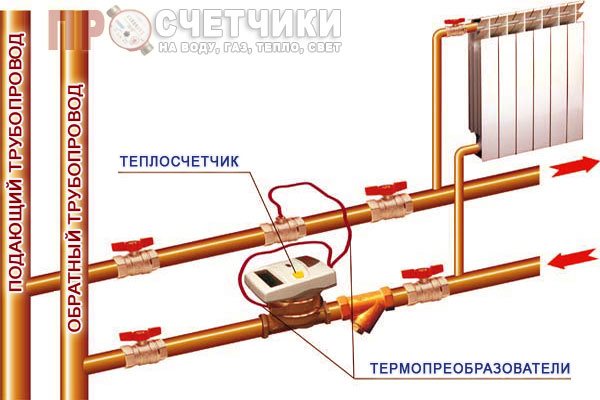

Modern manufacturers of metering devices offer users who have apartments in houses with vertical wiring, such distributors, where the measurement of the coolant flow rate is based on the difference in temperature between the air in the room and the surface of the battery. But still, the best option for houses with vertical distribution of heating pipes is a general house heat meter.
In houses with horizontal piping
If in an apartment building the piping is horizontal, then the residents have the opportunity to install any type of heat meter. For example: a compact model can be installed either on a pipe supplying a coolant to a room, or on a return pipeline.
When flushing the heating system is required
The frequency of flushing is always regulated by individual technical standards, but we can also talk about emergency situations, which include:
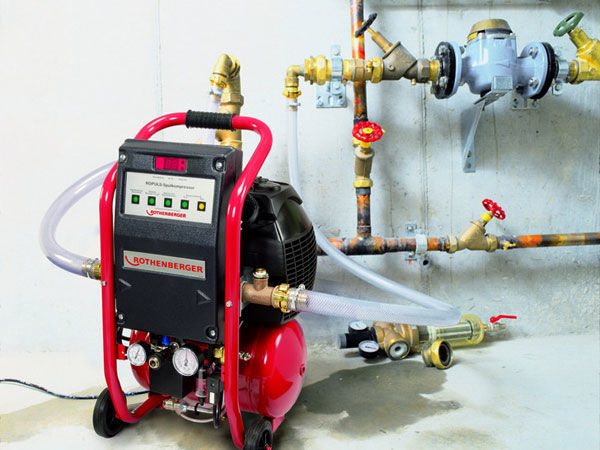

- Increasing the hydraulic resistance of the heating system to critical values. This hazard can be diagnosed exclusively on special equipment.
- Inefficient system operation.This is reflected in an increase in heating costs, uneven heating of devices, as well as significant fuel consumption. When deposits form inside batteries and pipes, their effectiveness drops significantly.
- Replacement of a separate section of pipes or several batteries.
- Preventive flushing of the heating system at home. Ideally, it should be carried out upon completion or at the beginning of the heating season, once every 3 years.
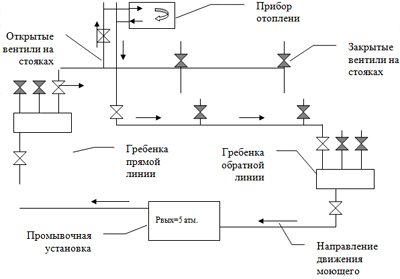

Installation of an individual heat meter
Step one
... It is necessary to eliminate the existing sources of heat loss, including cracks in the windows, insufficiently insulated entrance doors, freezing corners. Only after this installation of the heat meter will result in significant savings in money.
Step two
... The management company (ZhEK, HOA) must provide the owner of the apartment with technical specifications (TU) - they attribute the requirements that must be met in order to connect. Typically, the text of the conditions is on an A4 sheet. It certainly indicates information about the temperature and pressure of the coolant entering the pipeline of a particular house.
Step three
... Knowing these parameters, you can start buying a heat meter necessarily in a company operating legally. When purchasing a device, you must request a sales receipt and a cashier's receipt, a certificate confirming the quality, rules and instructions for use.
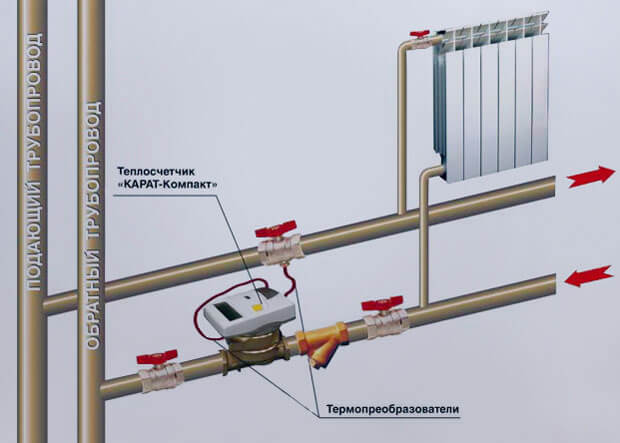

Step four
Step five
... The installation of a measuring thermal device is carried out by employees of a licensed organization specializing in this type of service.
When choosing a company, it is advisable to pay attention to a number of nuances:
- for the availability of information about the organization in the Unified State Register of Legal Entities;
- for the presence of a package of necessary documentation, including certificates, certificates, SRO approvals;
- for the availability of qualified specialists;
- for the presence of special equipment;
- to perform a complete list of installation works;
- for the availability of a free visit of a specialist to the client's apartment in order to inspect communications;
- for the availability of warranty obligations for the work carried out.
Step six
Features of mounting a meter for heat
It is important to know that measures for the installation and connection of the meter can only be carried out by organizations that have a special permit to carry out work of this type. Qualified specialists of such a company carry out all the work in several stages, namely:
- Carry out a connection project;
- Conduct project approval;
- Carry out the installation of a metering device;
- Register the installed equipment;
- The device is handed over and handed over to the supervising organization.
Types of devices
If you plan to install equipment in an apartment, then before starting to search for a suitable company that will carry out the installation, you will need to make sure that there is horizontal heating distribution in the house, when a separate pipe leaves from the central riser to each floor.
With one of the two types of vertical wiring, it is irrational to install an apartment meter, because there are several risers in the house, and you will need to install a separate apparatus for each of them, in this case, general house equipment is mounted, which records the readings of the heat meter of the entire building, and payment is made in accordance with the heated ones. square meters of housing.
You can go to the choice of the type of device. There is no ideal, and you will need to compare the pros and cons of each of them in order to determine the option that is acceptable for yourself out of four possible:
- Mechanical.
- Ultrasonic.
- Vortex.
- Electromagnetic.
Taking readings from a heat meter of any of these types does not have fundamental differences and can differ only in terms of designations and the number of recorded values.
What information does the meter give
A heat energy meter is a complex mechanism that records signals from sensors for the volumetric flow rate of the coolant, temperature. The calculating unit of the heat meter makes the appropriate calculations and gives results for the following parameters:
- the amount of heat energy used for a certain period (in giga calories);
- the amount of cooling energy (in giga calories);
- thermal power (heat energy consumption per hour);
- volumetric flow rate of the heat carrier (both in the supply pipe and in the return pipe. Measured in cubic meters per hour);
- the volume of the heat carrier in each pipeline (in cubic meters);
- the temperature of the coolant in the supply pipeline (in degrees Celsius);
- temperature of the heat carrier in the return line (in degrees Celsius);
- temperature difference (in degrees Celsius);
- date Time.
How to check the operation of a heat meter
One of the main characteristics of a heat meter is its ability to automatically calculate the amount of heat energy used. You can check this "math" using a conventional calculator. This requires the following data for the reporting period:
- the consumption of the heat carrier in the supply pipe;
- temperature of the heat carrier in the supply pipe;
- temperature of the heat carrier in the return.
We calculate the temperature difference in the pipelines and multiply the resulting figure by the coolant flow rate. We get the amount of used heat. This result should match the parameter indicated on the heat meter screen.
Before the start of the heating season, it is also recommended to check the meter:
- activate the work by clicking on the corresponding button;
- fix the readings;
- turn on heating radiators;
- after about an hour, check for changes in readings;
- if the data has not changed, there is information about errors or the image is missing, contact the management company or the organization that provides heat supply.
Positive and negative aspects of meters
Let's consider how to take readings from a heating meter in an apartment using the example of a mechanical type from SensoStar, Gross and Supercal. Such a device is equipped with an impeller, which rotates when the coolant flow passes. The part is connected to a sensor that reads revolutions and determines the volume of fluid. To set the current consumption, the device is equipped with a liquid crystal monitor, which shows the amount of thermal energy in Gcal, the volume of flowing hot water taken into account, the temperature of the carrier on the inlet and return pipes.
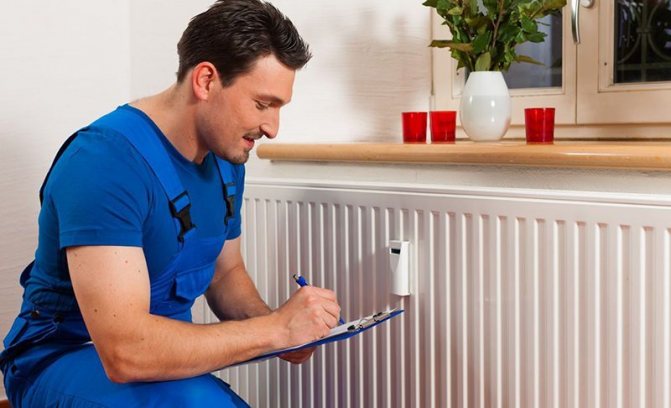

Ultrasonic equipment measures the speed and wavelength that travels along the flow of the coolant and back. In accordance with the received data, the calculation takes place. This type of device is ideal for metering the consumption of thermal energy in closed and open water supply systems. It is advisable to take readings of the heat energy meter from equipment from the German Sharky or the Ukrainian Sempal.
Vortex devices analyze the vortices formed when the coolant flow passes through the obstacle. It is not difficult to take readings from a heat meter of this type, but you will need the help of a qualified specialist who understands all the capabilities of the equipment and knows how to manage it. For installation we recommend Ultraheat, Karat and TSK products.
The readings of an electromagnetic heating meter are more accurate because the analyzer makes calculations based on measurements of the current generated by the passage of hot water through a magnetic field. Data retrieval is carried out directly, through a monitor with a control system, by connecting external drives, where archived data are copied, or through a remote connection. Among manufacturers, users also note Pramer.
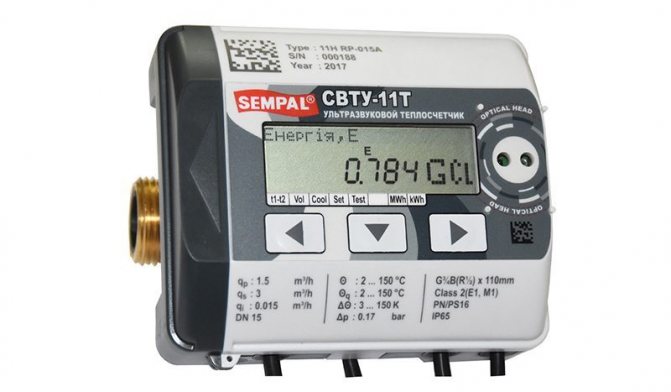

Types of heat meters
All heating meters available for purchase are divided into the following types:
Tachometric or mechanical
It measures the amount of coolant passing through the cross-section of the pipe using a rotating part. The active part of the apparatus can be screw, turbine or in the form of an impeller.The devices are affordable and easy to use.
The weak side of such devices is their sensitivity to dirt and dirt, rust, and water hammer sedimentation inside the mechanism. For this, a special magnetic mesh filter is provided in the design. Also, the devices are not able to store the data collected during the day.
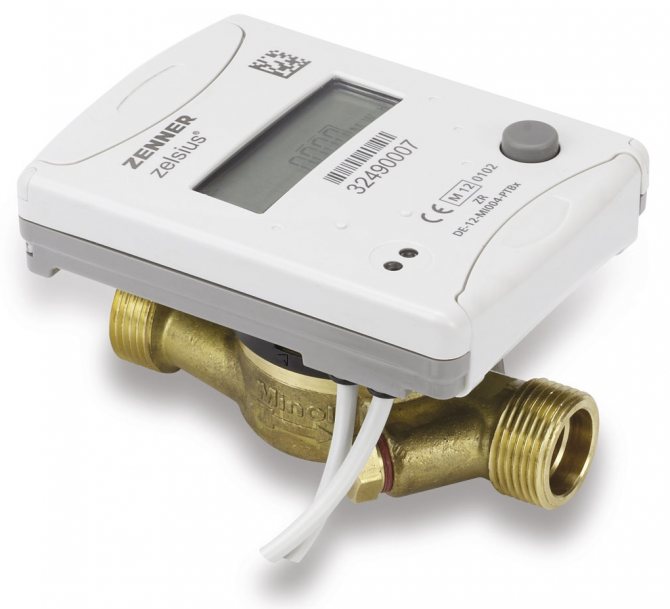

Ultrasonic
It is more often used as a general meter in an apartment building. Has varieties:
- frequency,
- temporal,
- Doppler,
- correlation. Works on the principle of generating ultrasound passing through water.
The signal is generated by the transmitter and picked up by the receiver after passing through the water column. It guarantees high measurement accuracy only if the coolant is sufficiently clean.
Electromagnetic
Differs in high accuracy of readings and cost. The operation of the device is based on the principle of passing a magnetic field through the flow of the coolant, which reacts to its state. The device needs periodic maintenance and cleaning. Consists of a primary converter, electronic unit and temperature sensors.
Vortex
It works on the principle of measuring the number and speed of vortices. Not sensitive to blockages, but reacts to the appearance of air in the system. The device is installed horizontally between two pipes.
Is it possible to be present when taking readings of heat meters
It is possible and even necessary. It is necessary to be present when taking readings from heat meters first of all for the peace of mind of the residents of the house, for the correctness of taking readings there is no need for this.
Why exactly for the peace of mind of the tenants?
Unfortunately, the times of Leonid Ilyich Brezhnev taught many to steal. I remember when the newspaper Argumenty i Fakty first appeared, it was something like Leninskaya Iskra, a piece of paper folded in half from the cheapest gray and yellow paper, it was 1980. We read the newspaper to the holes, passing it from hand to hand. I read there a conversation between Leonid Ilyich and someone from his entourage
Unfortunately, I don't remember with whom, but it doesn't matter
Leonid Ilyich was informed that the people live in poverty, the wages are miserable - although of course now one could argue with this. Leonid Ilyich replied - "so they can steal, no matter how lazy they are, I myself worked as a student unloading cars - I know."
These were the words of our leader, and it was the bitter truth; unfortunately, they cannot get rid of the very notion that one can live without stealing our older generation. In addition, the years of perestroika have even more convinced us in this. Therefore, the presence of representatives of the house at the first stages is simply necessary for the peace of mind of the tenants.
what it is necessary to have for taking readings from the heat meter
... Start a notebook or a small notebook, put it in a shield or box with an installed heat meter, and record the readings of the heat meter simultaneously with the reading by the service organization.
Reporting date of taking readings.
It should be noted here that each energy supplying organization has its own reporting date for taking readings and calculating payment for heat and it can change during the heating period. This period usually ranges from the 25th to the 31st of the current month and depends mainly on what day the weekend falls on. The number of days that fell into the reporting period because of this is different for each month, and depends on the period of taking readings in the current and last month.
Reporting period of taking readings for consumed heat also depends on the type of heat meter that is installed in your house.There are heat meters that send data for an arbitrary period, their data is taken from the heat meter to the storage panel - flash memory, and you can print the data for the consumed heat for any arbitrary interval.
However, there are heat meters, data readings from which are rigidly tied to the reporting date or the date of taking readings. The Germans, for example, went even further, in the heat meters there is already the amount of payment for the consumed heat. Reporting standardization date of taking readings from the heat meter is not subject and this feature must be taken into account at the design stage and selection of metering devices, heat meters. All of the above means that in one month the energy supplying organization can bill the management company for the consumed heat for 28 days and the next for 32, and this is not a violation.
Therefore, you need to find out the number of days for which you were billed for heat according to the heat meter, since the day of taking readings does not tell us anything.
Apartment heat energy meter how to correctly remove and transmit readings
Readings from apartment heat meters should be taken by analogy with water meters. The only difference is that heat meters display several indicators on the indicator and in order to choose the one you need, you should carefully read the operating instructions and strictly follow the manufacturer's recommendations. After receiving the necessary information, the difference in readings for the previous and reporting periods should be entered into the receipt for payment for heat energy, multiplied by the tariff set in the region, and the amount received should be paid.
At present, modern heat metering devices are equipped with a built-in interface that allows you to read data in automatic mode. For example, a domestically produced "Kombik-T" counter has a built-in radio antenna, which allows you to take readings from the device even without entering the apartment. It should be noted that a water meter (water meter) with a pulse output can be connected to such a device, which will allow taking readings of water consumption (hot and cold) also without visual contact.
The installation of such metering devices will be a good solution for people who often go on business trips or trips and cannot personally meet the controller who comes to take readings. Please note that an individual heat meter can only be installed in apartments with horizontal piping and separate heat carrier inputs. In houses where heating systems with vertical wiring are equipped, individual meters are not installed
From the information provided in this article, we can conclude that the procedure for taking and transferring readings from heat meters should be treated with a sufficient measure of responsibility.
Currently, in almost all Russian regions, charges for utilities occur according to the same scenario: the tenant transmits readings from his metering devices to the management company, and the Criminal Code takes readings from general household meters and calculates the difference in readings between them and individual metering devices.
If this difference is not more than the standards for common areas (staircases, corridors, basements, etc.), it is proportionally divided among all tenants. Otherwise, the management company pays the difference from its income. If the tenant has not submitted the readings from his metering devices to the Criminal Code in a timely manner, or his devices have expired the calibration interval, then the first two months the management company charges payment for the resources consumed, taking into account the average consumption for the previous period. In the future, the CM charges the payment based on the standards for a particular region.
Typically, the standards are significantly higher than the actual need for resources.For example, in central Russia in modern energy-efficient houses, the real heat consumption in 2-2.5 times less than the standard
... Accordingly, the timely transfer of testimony is primarily in the interests of the tenant himself.
The process of taking readings from a heat meter is described in. In this article, we will tell you a little more about how to take readings from the SANEXT heating meter.
General house meter readings
Heat metering devices are divided into industrial and apartment. Industrial models are used as general household.
The costs of purchasing common equipment are shared among the residents of the building.
In accordance with the provisions of the Decree of the Government of the Russian Federation of 05/06/2011 No. 354, the presence of a common house meter will avoid the cost of paying for heat, which did not even enter the building.
Having figured out how to take readings from the heating meter, each resident of an apartment building can check the correctness of the charges.
The volume of consumed heat is measured in different units:
Since the supply companies calculate the amount of heat in giga calories, it is worth choosing the appropriate meter. If the meter measures heat in a different quantity, the consumer should know that 1 Gcal is equal to 4.18 GJ or 1161.1 kW / h.
According to clause 31 of the aforementioned Resolution, every month from 23 to 25, a representative of a resource supplying organization or a management company takes data and enters them into the register of readings of general house meters.
The presence of consumers is not required. But each apartment owner has the right to contact the appropriate organization and get acquainted with the information recorded by the meter.
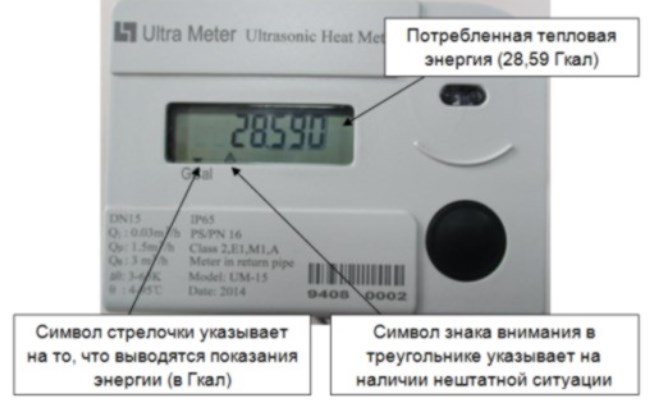

For more information on how tenants can control meter readings and billing, read the article “Household heat meter in an apartment building”.
Stage 6. Re-commissioning of UUTE into commercial operation.
Before each heating period and after the next verification or repair of the UUTE, the readiness of the UUTE for operation is checked - the re-entry of the UUTE into commercial operation. Based on the results of this inspection, an act of periodic inspection of the UUTE is drawn up.
The re-commissioning of the UUTE is carried out by a commission, which is created by the owner of the UUTE. The composition of the commission is similar to the composition of the commission created during the initial commissioning of the UUTE.
A call from a representative of Branch No. 11 "Gorenergosbyt" of PJSC MOEK to draw up an act of periodic inspection of UUTE is carried out at the written request of the client (owner of UUTE) addressed to the Director (or deputy director - head of the sales department) of Branch No. 11 "Gorenergosbyt" of PJSC "MOEK", provided in:
The application is submitted by the client at least 10 working days prior to the day of the proposed check of the UUTE. When re-putting the UUTE into operation, the commission checks:
- Compliance of the installation of UUTE components with the design documentation agreed with PJSC MOEK;
- Availability of passports, certificates of verification of measuring instruments, factory seals and stamps;
- Compliance of the characteristics of measuring instruments with the characteristics specified in the UUTE passport data;
- Correspondence of the measurement ranges of parameters allowed by the temperature schedule and the hydraulic mode of operation of heating networks, the values of these parameters determined by the contract and the conditions for connecting to the heat supply system.
In the absence of comments, the commission signs an act of periodic inspection of the UUTE installed by the client. When the act is signed, the UUTE is sealed in accordance with the design documentation for the UUTE, while the number of seals and their placement should exclude unauthorized interference with the operation of the UUTE.
If the members of the commission have comments on the UUTE and identify shortcomings that impede the normal functioning of the UUTE, this UUTE is considered unsuitable for commercial metering of heat energy, coolant.In this case, the commission draws up an act on the identified deficiencies, which provides a complete list of the identified deficiencies and the time frame for their elimination. This act is drawn up and signed by all members of the commission within 3 (three) working days. Re-acceptance of UUTE is carried out after the complete elimination of the detected deficiencies.
Application for periodic verification of ODU
Apartment heat energy meter how to correctly remove and transmit readings
Readings from apartment heat meters should be taken by analogy with water meters. The only difference is that heat meters display several indicators on the indicator and in order to choose the one you need, you should carefully read the operating instructions and strictly follow the manufacturer's recommendations. After receiving the necessary information, the difference in readings for the previous and reporting periods should be entered into the receipt for payment for heat energy, multiplied by the tariff set in the region, and the amount received should be paid.
At present, modern heat metering devices are equipped with a built-in interface that allows you to read data in automatic mode. For example, a domestically produced "Kombik-T" counter has a built-in radio antenna, which allows you to take readings from the device even without entering the apartment. It should be noted that a water meter (water meter) with a pulse output can be connected to such a device, which will allow taking readings of water consumption (hot and cold) also without visual contact. The installation of such metering devices will be a good solution for people who often go on business trips or trips and cannot personally meet the controller who comes to take readings.
From the information provided in this article, we can conclude that the procedure for taking and transferring readings from heat meters should be treated with a sufficient measure of responsibility.
Today I will tell you about how to convert Gcal to kWh and vice versa. The length, width, thickness of the object can be measured with a tape measure. The weight of an item can be determined by weighing it. But the amount of heat energy cannot be measured either with a tape measure, or with the help of scales or some other simple measuring instruments. Heat energy can only be calculated mathematically. Like any quantity, thermal energy has its own units of measurement.
Meters, centimeters, millimeters, decimeters, kilometers, nanometers and so on are units of measure for length. As you may have guessed, kilograms, grams, tons and so on are units of weight.
But Gcal, kW * h, J are units of measurement of thermal energy. Moreover, just as meters can be converted into millimeters, and kilograms into grams, so Gigacalories can be easily recalculated by turning them into kWh and J. When you install your heat meter, you will have to learn how to recalculate GCal to kWh and back.
You need to be able to do this in order to transfer the readings of this meter to your UK (managing company). The fact is that some meters give readings only in Gcal, and some only in kW * h. Management companies accept meter readings only in some one unit. So we have to recount every month. Recalculation is not tricky.
Let's say you want to convert 1 Gcal (one giga calorie) into kWh, then you need to remember that one kWh is equal to 0.000860 Gcal
... We make up the simplest proportion:
1kW * h = 0.000860 Gcal
We remember mathematics at school, and we calculate what is equal to X to W * h in this proportion: X = 1 kW * h x 1 Gcal / 0.000860 Gcal = 1162.8 kW * h
Or vice versa, you need to convert 1 kW * h (one kilowatt hour) to Gcal. Again we make up the proportion, remembering that one kWh is equal to 0.000860 Gcal
.
1kW * h = 0.000860 Gcal
Again, we do calculations based on the usual proportion: X = 1kW * h x 0.000860 Gcal / 1kW * h = 0.000860 Gcal
Here, in fact, we figured out the translation of Gcal in kW * h. Everything is easy and very simple. Especially when you make these simple calculations every month, after taking readings from a heat meter. We'll explain how to shoot them in the next chapter.
By the way, I deliberately did not give any coefficients for converting Gcal to J and kWh to J. Simply because usually such a unit as J (joules) is now practically not used. It's like decimeters in length. Decimeters seem to be as it is, you can and should know about them, and nothing more. The same epic with the Joules.
Another subtlety that you need to know about is the Kilo, Mega and Giga prefixes.
For example, kWh (kilowatt per hour), or MWh (megawatt per hour). Kilo means the number 1000, Mega - 1,000,000, but Giga - 1,000,000,000.
1 kW * h = 1000 W * h.
1 MW * h = 1,000,000 W * h = 1,000 kW * h.
1 Gcal = 1,000,000,000 Cal = 1,000 Mcal = 1,000,000 kcal.
Answers on questions. How to take readings from a heat meter.
Answers to the search queries of site visitors: how to take readings from a heat meter, how to correctly take readings from a heat meter, how heat is calculated from a heat meter. Let us analyze option 2a:
a) You take readings yourself, manually, i.e. just rewrite the values in the log.
Now there is no need for this (if only for self-complacency). New rules for commercial heat metering - the accounting journal was canceled. Is this good or bad. It is good that the quality of heat meters has increased so much that the need for logging has disappeared, all data at any time can be read directly from the heat meter directly or through a flash drive, computer or laptop.
On the next page - if the state installed the heat meter, then who should pay for the state verification?
It's bad if you have an old heat meter. Since this year, he is outlawed, which means he will live until the next state verification, after which the heat meter will have to be replaced without fail.
If you still want to take readings, for yourself, manually, for this, study the operating manual for your heat meter - the heat meter maintenance section, or the operating manual - a mandatory appendix to the project of a heat energy metering unit.
Moreover, the readings must be taken at the same time. You set the pick-up time yourself, as it is convenient for you, we recommend morning hours. The form of the accounting journal and the statement of account is also a mandatory attachment to the project.
What values are required for removal depends on the specific unit. As a rule, this is the temperature in the supply and return pipelines, the flow rate of the coolant in the supply and return pipelines is better in (t), the amount of heat energy received - the value can be in any units - Gcal, MW, kJ.
On counters of domestic production, these values look like this - Gcal; MW; kJ; imported kW (kWh-current); MW; MJ or GJ.
It's all the same for heating networks. They themselves will count to Gcal. For checking, I recommend you download the Metrix program or remember that 1 Gcal is 1.163 MW (MW) or 4.187 GJ (GJ). The last required value is the operating time of the meter or operating time.
b) You take readings yourself (the rules do not prohibit this) with the help of technical means - a storage panel, a printer, a laptop. The most acceptable for you is, of course, the printer - with it you will make the least mistakes.
How to shoot, again, is in the "instructions" - an appendix to the project. Of course, I would recommend you to hire specialists. Why - read here.
If you hire specialists, for control, put a small notebook in the shield with the heat meter, where they will record for you the date of reading and the amount of heat energy at the time of reading. Speak up your demand in advance, before the conclusion of the contract, otherwise they have every right to refuse.
By analyzing the readings, you can easily control the amount charged to you for heat by heating networks. And it is imperative that they themselves transmit the readings to the heating networks, otherwise why do you need them. As my first master said, this kind of work can be done by a monkey if he is taught to press buttons.
One final note, never try to save heat by cheating. With modern control methods, everything is very easy to control. Punishment of legal costs and payment of five times the amount. The best savings is to get rid of heat loss.
How to correctly take readings of the kwh metering device produced in 1985;
Read a little higher - section "a"... I would recommend replacing the heat meter of 1985, because already in 1995, after the rules for accounting for heat energy and coolant were issued, it ceased to comply with them, and it does not comply with the new rules all the more, and the worst thing is that it does not know what.
According to the operating experience, the heat meters of 1998-99 do not pass the state verification - they do not correspond to the declared parameters due to wear and tear. Although there are individuals, so the 1961 manometers undergo state verification without additional adjustments, and new ones do not pass it out of the box. It all depends on the manufacturer.
How heat is calculated;
The amount of heat energy received is calculated in Gcal. It is accepted for calculation by heating networks in any values - it can be - Gcal, MW, kJ, GJ.
On counters of domestic production, these values look like this - Gcal; MW; kJ; Imported kW; MW; MJ or GJ. For heating networks, in what quantities you transfer data anyway. They themselves will count to Gcal.
1 Gcal is 1.163 MW (MW) or 4.187 GJ (GJ).
Saving heat with UUTE.
The heat metering unit calculates heat, but does not save. But according to it, it is very easy to control losses, and the effectiveness of measures to eliminate them. Think of the open vents and balcony doors in the spring. If you want to know what savings in monetary terms it will bring after installation, and how long it will take to pay off, read following article.
Is an SRO (old license) required for the installation of heat meters;
Yes, the answer is unequivocal. In addition, the specialists of the company installing the devices are required to have initial training and valid certification in the technical supervision authorities. Therefore, if you are a manager concluding a contract, check the certification documents with the contractor in advance. Otherwise, your heat meter will never become commercial.
How to install a heat meter yourself; Do I have the right to install a heat meter myself;
As follows from the above, it is impossible, and moreover, I do not advise you to undertake this. The rules for installing heat meters from different manufacturers are very different from each other. Even if you are a heating engineer, metrologist, instrumentation engineer, welder, electrician, plumber, in one person, which is unlikely, you will have to remember or study all the rules, GOSTs, SNiPs and also installation manuals for this heat meter. The cost of services in this market has now dropped. And the area of heat supply is so complex that sometimes even specialists lack knowledge and experience. My personal opinion is that it is high time for us to forget the communist times and make money where we work. Fortunately, this is not prohibited now. No offense. I myself am just like you. Brought up in the days of the communists, I can do everything better than modern "specialists". For which children constantly scold me.
How heat meter readings are calculated;
The following is accepted for calculation: - the amount of heat energy received by the heat meter. - the amount of heat used to feed the heating system, if there was a leak in the heating system. In this case, the possible error of flow meters and the permitted standard water leakage from the heating system must be taken into account. - losses of heat energy to metering devices in accordance with the contract.These data are summed up and multiplied by the cost of 1 Gcal.
How to check if the heat payment has been correctly calculated by the heat meter;
Calculate the difference, Q value - the amount of consumed heat energy between the last and the penultimate reporting dates. As, for example, if it was an electric meter. Convert the readings of your heat meter to Gcal. To do this, if you have Q in MW, multiply by 0.8598, if in GJ, multiply by 0.2388, you will get the value in Gcal. Add in the amount of contractual losses, if any. Losses must be specified in the contract and scheduled by month. Multiply the amount of heat received by the cost of 1 Gcal. If this value differs from the one set for you, check if you have had water leaks from the heating system. To do this, look at the flow rate readings, parameter G in (t) as well as in the case of Q by reporting dates. If the data does not differ by more than 2% (for closed heating systems), in some heating networks they accept 4%, 2% error of one flow meter, 4%, respectively, of 2 flow meters - flow meters are devices that count the amount of water that has passed through your heating system or hot water supply. If they differ, it means that you were charged an additional cost for drawing water from the heating system. It is considered so. The amount of water intake, (taking into account the error of the devices) in (t) is multiplied by the temperature difference between the return pipeline and the temperature of cold water for a given period. They get the value in Gcal, which is added to the heat consumed by you. Data are usually rounded to whole values, the remainder is carried over to the next reporting period. Checked, you can now go argue or sleep peacefully. I am always in control, because mistakes are common, both through the fault of people and the fault of programmers who write programs for reports.
Read more - Who has the right to change the settings of the heat meter (heat meter)
You can ask us a question by calling the contact numbers, or by sending it to the e-mail address
Paramonov Yu.O. Rostov-on-Don. 2013-17 Exclusively for Energostrom LLC
What else to read on the topic:
Related entries:
- Heat meter DIO_99 - how to take readings?
- Who has the right to change the settings of the heat meter
- How to calculate the payment for heating by the meter
If you need more temperature, humidity, voltage, current and more
Starting with resource accounting, we went further - we organized an opportunity through the KUB-Infra service to monitor temperature and humidity, voltage and current, as well as remotely control something at objects, for example, by one click to de-energize all sockets.
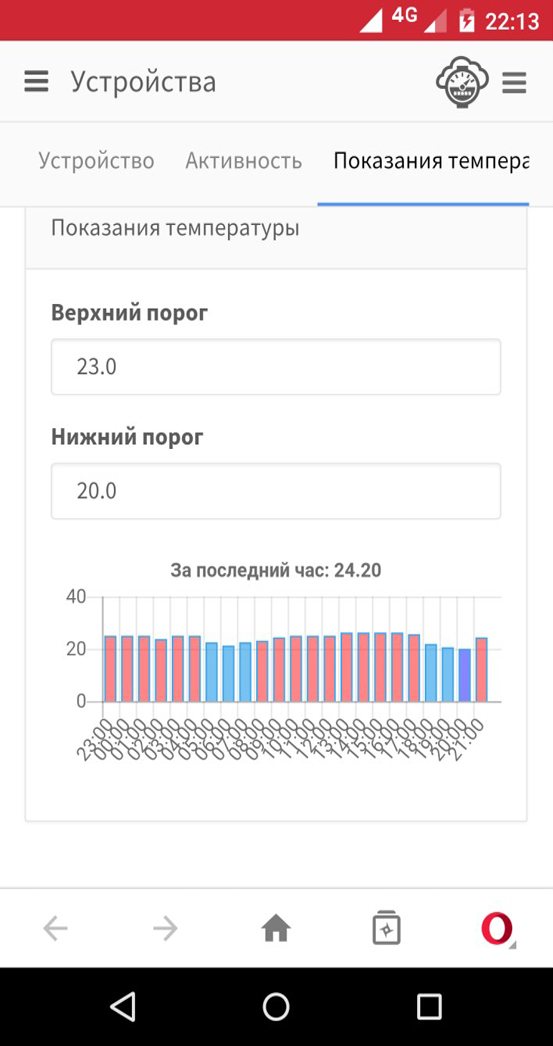

It is especially pleasant that all these functions can be organized using the same KUB-Infra controller. The device provides all the corresponding sensor I / O. Therefore, if, in addition to accounting for resources, you need to organize something else, it is enough to purchase an appropriate sensor (temperature, humidity, current sensor, voltage control unit, etc.), and connect it to KUB-Infra. You will track the parameters in the same place - in your personal account on the KUB-Infra service. At the same time, if the parameter goes beyond the normal range, the system will notify you about it by e-mail or via a messenger.
When using apartment heat meters, heating costs can be significantly reduced. All this happens not only due to more accurate accounting of the consumed heat, but also due to the fact that the consumer is interested in more economical consumption of thermal energy. He begins to regulate the flow rate of the coolant through his heater in the apartment, as well as to insulate walls, windows, etc.
Sometimes the benefits are obvious and the heat meter pays for itself in a matter of months, but the opposite often happens, when the consumed amount of energy comes out of the meter more than according to the standard indicators. We will talk about how to choose the right counter and the need to install it in this article.
What should you pay attention to and whether it is worth installing a meter.What needs to be considered when deciding to install a meter Registering a heat meter How to take readings correctly? You decided to install a meter, what should you be guided by when choosing an installation organization
Self-installation
Before installing a heat meter in a private house, it is better to prepare all the necessary elements and tools. So, you need:
- the heat meter itself;
- connecting elements for contact with a non-return valve;
- filter elements;
- welding machine, when it comes to plastic lines;
- a wrench if metal pipes are used;
- collet;
- special fittings with thermal sensors;
- heat transfer paste.
The first step is to flush the heating lines, where the measuring equipment will be mounted. After this procedure, you can start installing the flow elements of the heat meter. When performing this operation, you must adhere to the following rules:
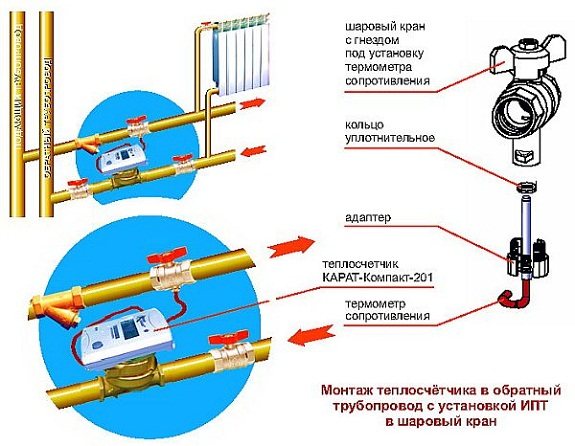

Installation of a heat meter in a ball valve
- Installation of this equipment should be carried out only in strictly horizontal or vertical sections of the line.
- The liquid crystal valve must be mounted so that the calculator is at the top.
- The flow element of the heat meter must be filled with water at all times.
- The supply air must be installed using a set of threaded connectors. Any model of this measuring equipment is completed with these elements.
- This part must be positioned so that the direction indicator is aligned with the direction of the fluid flow.
By clicking on the link, you will learn how to choose a pump for heating. Read about how to install water meters here. You may also be interested in the process of installing underfloor heating under the screed.
All contacts should be as tight as possible. This condition must be met so that all elements can withstand pressure up to 1.6 MPa. Only in this case can the possibility of leaks be completely excluded.
It is necessary to use adapters if the diameter of the flow element of the heat meter exceeds or vice versa the diameter of the line.
Now all that remains is to install the measuring cartridge and transducers. It is very important to inspect the heating main for pressure build-up before starting this work. It is imperative to make sure that the shut-off valves are closed. This is followed by an inspection of the measuring device and flow element. If these items are in order, you can proceed with the installation.
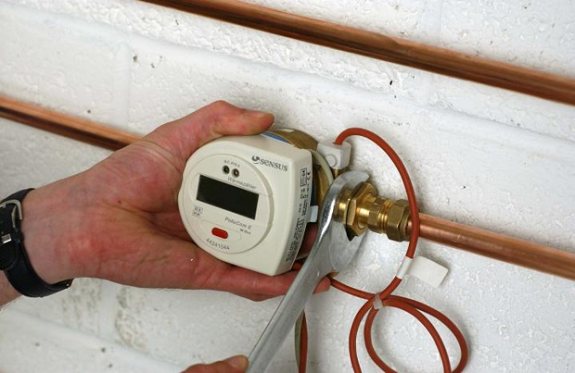

Installing a heat meter
It's important to know! During installation work, it is unacceptable to use old rubber seals.
Thermal converters should be installed at this stage. They must be installed on both the supply and return lines. In order not to be confused, it is better to pay special attention to the designations on these elements. The supply line is marked in red, and the return line is blue or black. They are installed in a special niche, which is located on the measuring product.
The first step is to roll up the plug that blocks access to the niche, then arm yourself with the tool that comes with each measuring equipment and mount the rubber seal. The thermal converter itself must be located in a special plastic element, consisting of two fragments. At this stage, it is very important to ensure that all gutters match. After that, you need to mount the resulting structure in the niche of the measuring chuck and tighten it tightly with a wrench.
The second thermal converter must be placed in a sleeve, which must then be screwed into a tee, which is attached to the heating main.Before installation work, the sleeve should be treated with a thermally conductive compound. The contact areas must be insulated with a special material that does not conduct heat. The last step will be sealing the heat meter. As you can see for yourself, the installation diagram of the heat meter is quite simple, so if you are confident in your abilities, then it is better not to waste money.
Back to content
Data reading methods
If you have a visual reading device installed, you can only take readings directly from the information board. The consumer can record the data himself, and then transfer it to the management company or service provider organization. In addition, employees of the management company or the heat supply service can take readings. The consumer is obliged to provide them with access to the heat meter located in the apartment.
Remote reading of data is also possible. To do this, the device must be equipped with one of the following modules:
- pulse output. It is equipped with a sealed contact, the closure of which leads to the formation of an electrical impulse. This impulse is recorded by a reading device that transmits information to an automated control center;
- radio output - information is transmitted over a radio channel, independent of cellular communications;
- digital output. The RS-485 interface is used. Data is transmitted over a wired communication line.
Remote reading is relevant if access to the heat meter is difficult or if a common house metering system is organized in an apartment building. Equipping the devices with these modules allows not only to remotely read information, but also to store it in a non-volatile archive for further viewing, output to paper, and entry into reporting documentation.
Receiving readings from the VIST heat meter using a printer
To display information, you will need a printer connected to the LPT connector on the computing unit of the heat meter. Printing is enabled from the main menu of the heat meter. Procedure for creating a report:
- Connect a printer to the heat meter
- In the heat meter menu, using the Left / Right buttons, find the line "Monthly report"
- Press the enter button and enter the report menu
- Then press the Up button, select the start date, then the Down button and select the end date of the report
- Press the Enter button 2 times, after which the print mode is activated
Restrictions on installing a heat meter in an apartment
In such a situation, there is only one solution - to put meters on heating batteries, but such a solution is difficult to implement for the following reasons:
- the installation of several heating devices in one apartment will cost its owners a tidy sum, since each meter for a heating battery costs a lot of money;
- taking readings from each device is hampered by the fact that utility workers are not able to monthly walk all the rooms around the apartments of the house in order to record the data. When doing this work on your own, you can get confused in numbers and make mistakes in calculations;
- maintenance problems - several instruments are much more difficult to monitor and verify that they are functioning correctly;
- the meter for the heating radiator has poor accuracy, since the difference at its inlet and outlet is so small that the device is often unable to fix it.
A heat meter - a device for accounting for the consumed heat carrier, is currently very profitable, since it allows you to save money by paying only for the consumed heat, excluding overpayment.
An important point is the correct choice of the type of device, depending on the installation location and design features of the heating network, as well as the conclusion of an agreement with a service organization that will monitor the technical condition of the device.
There are many models of heat meters, differing in design and size, but the principle of how a heating meter works has remained the same as on the simplest device that measures the temperature and flow rate of water at the inlet and outlet of the pipeline of a heat supply facility. Differences appear only in engineering approaches to solving this issue.
The operation of the heat meter is based on the principle of calculating the amount of heat using data taken from a coolant flow sensor and a pair of temperature sensors. The amount of water passed through the heating system is measured, as well as the temperature difference at the inlet and outlet.
The amount of heat is calculated by the product of the flow rate of water passed through the heating system and the temperature difference between the incoming and outgoing heat carrier, which is expressed by the formula
Q = G * (t 1 -t 2)
, gcal / h, in which:
- G
- mass flow rate of water, t / h; - T 1, 2
- temperature indicators of water at the inlet and outlet from the system, o C.
All data from the sensors are sent to the calculator, which, after processing them, determines the value of heat consumption and writes the result to the archive. The value of the consumed heat is shown on the display of the device and can be read at any time.
What affects the accuracy of the heat meter
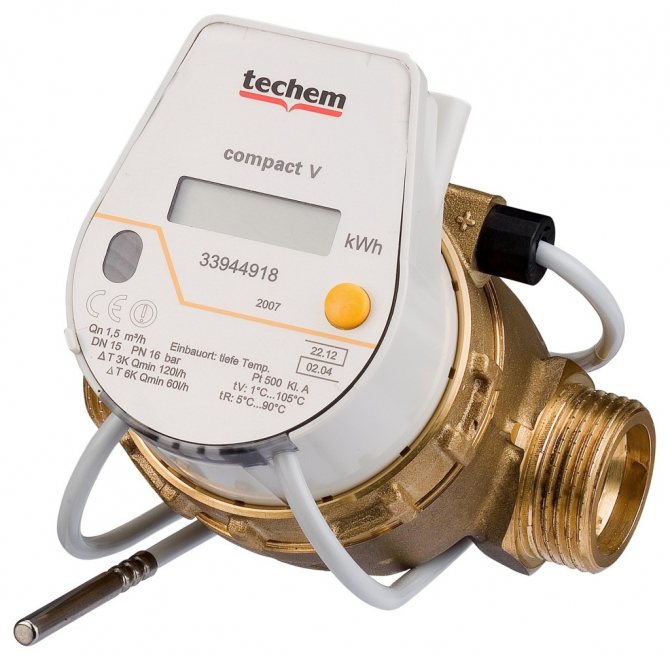

Techem compact V
A heat meter, like any precise device, when measuring the consumed heat, has a certain total error, which is the sum of their errors of temperature sensors, a flow meter and a calculator. In apartment accounting, devices are used that have a permissible error of 6-10%. The real indicator of the error may exceed the baseline, depending on the technical characteristics of the component parts.
The increase in the indicator is caused by the following factors:
- The amplitude of the entering and leaving temperature of the coolant, which less than 30 o C
. - Violations during installation in relation to the manufacturer's requirements (when installed by an unlicensed organization, the manufacturer removes his warranty obligations).
- Inadequate pipe quality, hard water used in the coolant, and the presence of mechanical impurities in it.
- When the flow rate of the heating medium is below the minimum value indicated in the technical characteristics of the device.
How is the consumed heat measured?
It is customary to calculate the rate of consumed heat in giga calories. The unit of measurement refers to non-systemic, and has traditionally been used since the existence of the USSR. Appliances manufactured in Europe calculate consumed heat in GigaJoules (SI), or the internationally accepted non-SI unit kWh (kWh)
.
Principle of operation
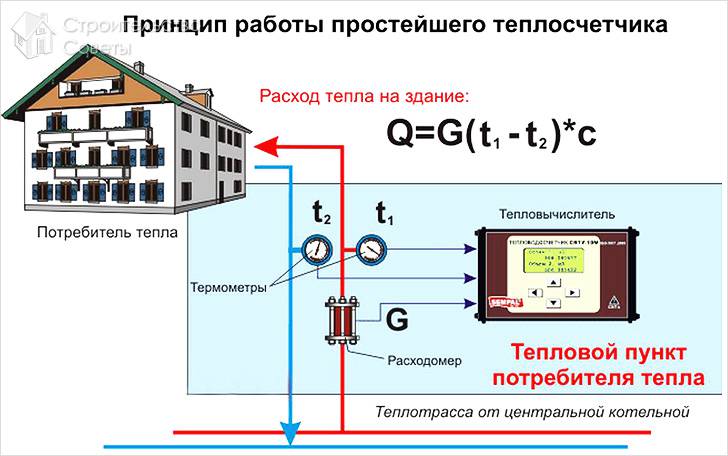

The heat meter makes measurements based on the following data:
- Consumption of hot coolant that is delivered to the heating system.
- Heating system inlet temperature.
- The temperature at the outlet of the heating system.
Based on the results of the device's operation, a figure for heat consumption is obtained, which is measured in hectacalories - for a year, month and day.
The advantage of modern devices is that they are able to store the necessary information, namely about heat consumption, for up to 10 years. In this case, information can be read from the Internet via a computer.
Breakdowns and repairs
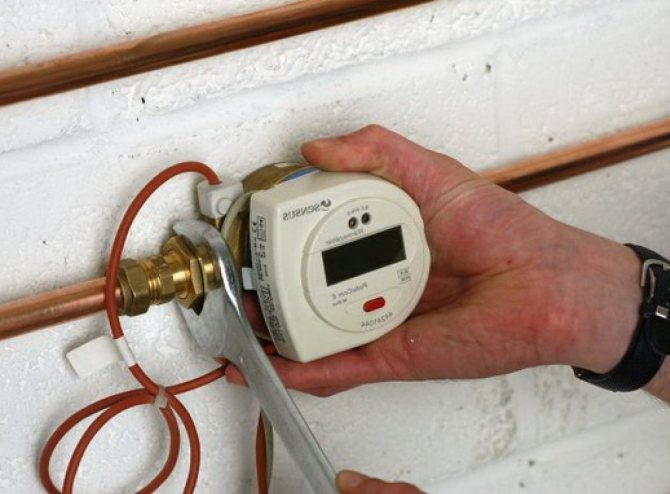

Maintenance of the device is limited to maintaining it in good working order, regular inspection, avoiding causes that cause premature wear and tear. According to clause 80 of the Rules for commercial metering of the coolant, all work on maintenance and control of the correct operation of the meter is carried out by the consumer. On the part of the owner, he does not need special care.
The lithium battery or batteries that power the device are not recyclable and are disposed of if they fail.
If any malfunction is detected in the metering device, the consumer must within 24 hours.notify the service company and the heat supply organization about this. Together with the arrived authorized employee, an act is drawn up, which is then transferred to the heat supply organization with a report on heat consumption for the corresponding period. If the failure is not notified in time, the heat consumption is calculated in a standard way.
The service company will provide services for the repair or replacement of the meter, and during the repair can install a replacement device. The cost of installation and dismantling, repair and other services is regulated by the contract between the consumer and the service company.
Error logging
As a standard, heat meters are equipped with a self-test system that can detect inaccuracies in operation. The calculator periodically queries the sensors, and in case of their malfunction, it fixes the error, assigns a code to it and writes it to the archive. The most common logged errors are:
- Improper installation or damage to temperature sensor or flow meter.
- Insufficient battery charge.
- The presence of air in the flow path.
- No flow if there is a temperature difference for more than 1 hour.
Removal and installation of the heating meter
Before installing a meter for heating in an apartment or an apartment building, specialists from specialized companies that have permits for this type of work are invited. Based on the specific situation, they can make the following commitments:
- Develop a project.
- Submit documents to certain authorities in order to obtain permits.
- Install and register the device. In the absence of registration, payment for the supplied heat is made in accordance with the established tariffs.
- Carry out test tests and put the device into operation.
The developed project should include the following points:
- The type and device of the model, which is designed to work in a specific heating system.
- Necessary calculations for heat load and coolant flow rate.
- Heating system diagram with the place of installation of the heat meter.
- Calculation of possible heat losses.
- Calculation of payment for the supply of heat energy.
Error logging methods
The following factors affect the accuracy of the readings of heat meters in the calculation:
- readings of temperature sensors;
- flow sensor data when calculating the volume of the coolant;
- the accuracy of processing the received signals.
As a rule, all modern metering devices are equipped with a self-test program that regularly checks the equipment and registers an error if damage is found. The most common causes of problems are:
- lack of food;
- malfunction of the calculator or temperature regime;
- memory damage.
According to clause 89 of Resolution No. 1034, in the event of violations, the consumer is obliged to notify the service organization within 24 hours. After that, an act is drawn up, which is transferred to the heat supply company.
It is legally established that at least once a year, the performance of the heat meter should be checked, namely:
- serviceability of each measurement channel;
- the presence of seals and the validity period of the verification;
- permissible measuring range;
- the characteristics of the settings of the heat meter.

